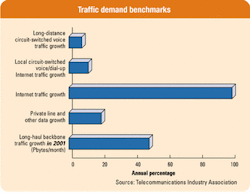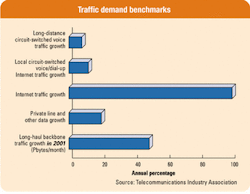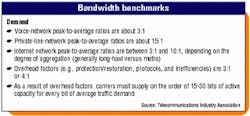TIA calls for more U.S. optical capacity
trends
At the behest of some of its members, the Telecommunications Industry Association (TIA) has tackled the question of whether there's a fiber glut in the United States. The answer, according to the recently released white paper "Fiber Optic Network Capacity and Utilization, Part II," is, it depends on where you look. The TIA confirms that most long-haul routes between tier one cities have enough capacity to meet expected demands for the next one or two years. However, the white paper suggests that the amount of optical capacity within tier one cities—as well as between tier two and three cities—falls short of carrier requirements and needs to be enhanced.
As its title implies, "Part II" of the TIA's look at optical capacity in the United States follows an initial white paper released last June. That effort defined terms and established metrics for capacity, utilization, and demand (see "With definitions set, TIA approaches the fiber glut question," Lightwave, August 2002, page 1). The paper also placed these terms within the context of carrier planning parameters, highlighting the necessity to engineer networks for peak demand rather than average use. It also stated that this demand includes requirements for protection and overhead bandwidth and that peak-to-average ratios for data can be significantly greater than those for voice.The new white paper offers benchmarks for some of the metric points defined in "Part I" (see Table), describes bandwidth demand trends and looks at how well current U.S. optical capacity tracks with those trends. The TIA interviewed six carriers (two long-haul carriers, three metro service providers, and an RBOC), eight vendors, eight analysts, and three members of academia as part of its research.
The TIA confirmed several commonly held beliefs such as the notion that Internet traffic growth is about 100% annually and that peak-to-average ratios for voice are 3:1. It also put the peak-to-average ratios of private line networks (which for all practical purposes the TIA considers to be 100% data) at 15:1 and for Internet networks at anywhere from 3:1 to 10:1, depending on the degree of aggregation.
In examining the current state of network capacity, the TIA concludes that the optical bubble saw most carriers focused on building long-haul capacity—mainly among the same tier one cities. Thus, in the three years from 1997 to 2000, backbone fiber deployment in the United States increased by a factor of five within an overall market context in which fiber deployment rose by only a factor of 1.5. Not surprisingly, the TIA cites figures from financial and market research sources that estimate only 25% of fiber in U.S. backbone networks is lit.
While the TIA quotes carriers as being generally dismissive of the usefulness of the percentage of lit fiber as a benchmark for industry health or capacity requirements, bandwidth availability between tier one cities generally should not be an issue for the next year or two, the study concludes. (The TIA, however, points out that some carriers may experience shortages on some of these routes, depending on their individual infrastructure composition and customer demand.) But the white paper states that between 45% and 75% of metro fiber had been lit by the end of 2001. It is here where opportunities may present themselves for near-term optical capacity purchases.
"In many of the metro areas, in the residential/access market, between certain tier two and tier three cities, and even between some tier one cities, we feel that carriers are either approaching a trigger point in their capacity utilization or have even surpassed it, and there actually is not sufficient capacity for the traffic peaks that they have," states Eric Nelson, the TIA's vice president of global network marketing.
But needing capacity based on historical benchmarks is one thing; doing something about it is another. KMI Research (Providence) recently reported that carriers have changed their buying strategies when it comes to new DWDM equipment (see "Carriers will delay equipment purchases" by Neil Dunay, Lightwave, September 2002, page 29). While carriers historically have upgraded their systems when current equipment reaches between 50% and 70% of capacity, KMI says carriers will now defer new purchases until current systems are at 80% of capacity or greater. Similarly, Merrill Lynch estimated earlier this year that U.S. network use should reach historic purchasing trigger points by the end of 2003. However, at NFOEC in September, Merrill Lynch analysts predicted that the optical equipment market won't see an upturn until the first half of 2004 (see related story on page 1, "Wall Street eyes 2004 for possible industry recovery").According to Nelson and TIA director of emerging technologies Mary Beth Boswell, who did much of the research for the reports, the TIA did not investigate whether the economy will delay capacity upgrades. Yet, the most recent white paper implies that such delays could be significantly troublesome to fiber vendors due to the very long cycle times associated with network builds. The TIA estimates that it can take as much as two years to install a new long-haul link if the carrier, for example, needs to obtain rights of way and dig new conduit.
Meanwhile, Nelson and Boswell say they see a need for continued dialog on the issues of capacity measurement, bandwidth demand, and related market drivers among members of the communications space as well as with the financial analysts and general media who are observing it. The TIA is interested in setting up a mechanism for such an information exchange but has not formally established a plan.
Copies of both parts of the TIA study on optical capacity can be found on the organization's Website, www.tiaonline.org.


